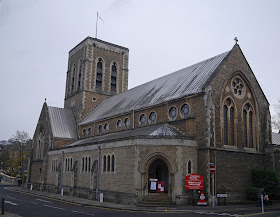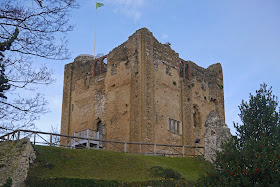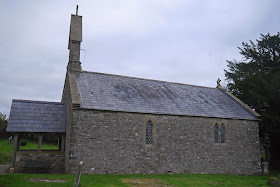St Mary's church
The rare prospect of a sunny day inspired me to visit Ewelme to see the celebrated almshouses and walk on the downs. I found a nice route on the
Wallingford Welcome website and parked as directed at the small car park by the recreation ground. From here I walked in to the village to first of all see the church.
It dates from a rebuilding of about 1432, although the early 14th century tower is from the earlier church. It was founded by Alice Chaucer, grand-daughter of the poet and WIlliam de la Pole, Earl (later Duke) of Suffolk. The grave of the novelist Jerome K Jerome (Three men in a boat) is in the churchyard.
You can look over the churchyard wall to see the facade of the almshouses, founded in 1437, also by the Earl and Countess. You follow a winding path downhill to find the entrance.
This leads you through a garden, and then through the castellated arch you can see in the picture above, to the entrance to the almshouse proper. According to Pevsner the almshouses are unusual for being one of the earliest brick-built buildings in Oxfordshire. The elaborate arch with its trefoil pattern is similar to brickwork of the same date in Bruges and may have been the work of a Fleming.
The House of God, as the almshouse is called, is also notable for being one of the earliest examples of an almshouse being built on a collegiate plan around a quad. The quad is surrounded by a lovely cloister.
Next to the almshouse is another fascinating building the (C of E) primary school which also dates from 1437 and had the same benefactors. It is thought to be the oldest primary school currently in operation. The massive chimney breasts, which also function as buttresses, are imposing.
Now back to the car park to start the rural part of the walk. You follow a section of the Chiltern Way across a plateau, with a vast pig farm on the left. After half a mile or so there is a descent down to a lane, with the splendidly named Sliding Hill ahead on the right, with Lower Farm further to the right.
You follow the road for a while and take a right shortly before the hill, now following Swan's Way south for about a mile and half beside large fields. Eventually, with a shallow winding valley joining from the left, you turn right, still following Swan's Way.
Where this reaches the road from Wallingford and turns left, the walk route goes ahead on a small path, but I remembered I had noticed a fine view of Ewelme at a point to the right so I detoured to take a picture. For some reason the picture I took didn't really do justice to it, but there is a very pleasing group of buildings (the one on the right is the Georgian Old Rectory).
But what is Swan's Way (not to be confused with Swann's Way by Marcel Proust)? From Wikipedia I learn that it is a 65 mile route from Salcey Forest in Northamptonshire to Goring on Thames, designed primarily for horse riders. A useful blog,
Pete's Walks, gives more information. But who was Swan?
Departing the Way, I followed a couple of footpaths to enter the village of Ewelme to join the definitive The Street. Turning right would complete the walk by passing teh school and returning to the car park, but I was so much enjoying being our in the fresh air that I decided to complete my tour by turning left and seeing the remainder of the village. The highlight was the King's Pool, with the 1826 village Store beyond.
I returned to the car via the church and many more fine old houses.
Conditions: bright, sunny, quite warm.
Distance: the walk route was 4.5 miles and I did another mile or so wandering round the village.
Map: Explorer 171 (Chiltern Hills West).
Rating: four stars.






















































